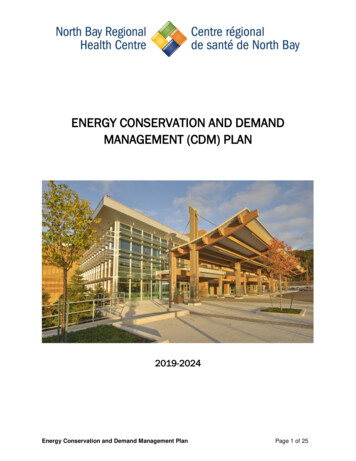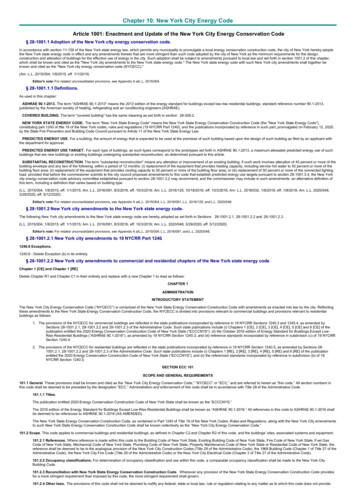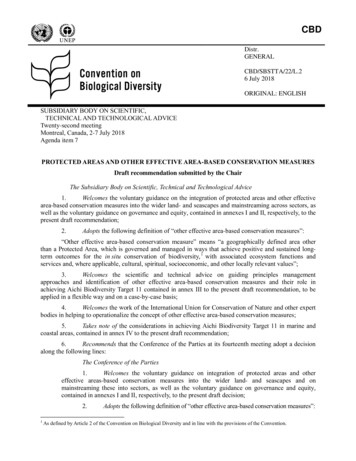
Transcription
ENERGY CONSERVATION AND DEMANDMANAGEMENT (CDM) PLAN2019-2024Energy Conservation and Demand Management PlanPage 1 of 25
Table of ContentsIntroduction . 3Our Mission: . 3Our Vision: . 3Our Values: . 3Energy Matters . 4NBRHC Facilities covered by this CDM plan . 5Energy Management Vision . 18Guiding Principles for Strategic Energy Management . 19Energy Management Goals 2019 - 2024 . 21Closing Comments . 25Energy Conservation and Demand Management PlanPage 2 of 25
IntroductionThe purpose of North Bay Regional Health Centre’s (NBRHC) Energy Conservation and DemandManagement (CDM) plan is to promote good stewardship of our environment and communityresources.In keeping with our core values of accountability and excellence, NBRHC’s Energy Conservation andDemand Management program will aim to reduce overall energy consumption, operating costs, andgreenhouse gas emissions. It will also enable us to provide innovative patient-centered care to agreater number of persons in our community, with a focus on compassion. The plan will also meetthe requirements outlined in sections 4, 5, and 6 of the Ontario Regulation 507/18 Broader PublicSector: Energy Reporting & Conservation & Demand Management Plans under Electricity Act, 1998.The Ontario Regulation 507/18 can be found Our Mission:“Partnering in care, we restore and maintain health for mind and body”Our Vision:“Working with you to be the best in health care”Our Values:“iCare: Innovation, Compassion, Accountability, Respect, Excellence”Energy Conservation and Demand Management PlanPage 3 of 25
Energy MattersThe North Bay Regional Health Centre has partnered with Johnson Controls and BGIS which act asthe FM Service Provider for the facility. Over the last two years, NBRHC recorded the followingimprovements as a result of optimizing the energy systems, as shown in Table 1. 1.7% reduction in energy use 69,017 saved from decreased energy consumption368,951 kWh decrease in electricity consumption117,702 m3 decrease in gas consumption251 tonne reduction in carbon dioxide equivalent (tCO2e) emissionsTable 1: Energy, Cost, and GHG Reductions over the Last Two Years:Gross ElectricityFiscal Year(April to March)Consumption[kWh]Purchased Natural GasCosts with Taxes[ ]Consumption[m3]Costs with Taxes[ ]**Energy Use[ekWh]Total Cost ofElectricity & Gas[ ]GHGsElectricityCO2[tons]Natural GasCO2[tons]TotalCO2[tons]Y 7 2016-201724,378,708 1,988,1986,488,662 1,950,92392,311,397 3,939,1211,95012,19214,142Y 8 2017-201824,161,248 1,213,6406,418,607 2,049,17991,360,503 3,262,8191,93312,06113,993Y 9 2018-201924,009,757 899,8296,370,960 1,752,21790,710,170 2,652,0461,92111,97113,892Annual ReductionsY 8 2017-2018217,460 774,55870,055 (98,256)1.0% 676,30217132149Y 9 2018-2019151,491 313,81147,647 296,9620.7% 610,7731290102Total Reductions368,951 1,088,369117,702 198,7061.7% 1,287,07530221251NBRHC is entering operational year 10. The energy & GHG performance parameters of the fiscal year9, April 1, 2018 to March 31, 2019 were as follows as depicted in Table 2: Annual energy spend on electricity and gas were 2,652,046.The Hospital’s Energy Use Index (EUI) was 126 ekWh/ft2, factoring in the gas used forcogeneration plant.Energy related GHG emissions were 13,892 tCO2e, based on emission factors of 2013 fromEnvironment Canada.Table 2: Energy Spend and GHGs for Operating Year 9, 2018-19:Fiscal Year(April to March)Purchased[kWh] *Y 9 2018-201912,353,884ElectricityPurchased Natural GasTotal GrossGross In HouseFacilityTotal Cost ofEnergy UseCogeneration Consumption Costs with Taxes Consumption Costs with Taxes Electricity & GasIndex[kWh][kWh][ ][m3][ ]**[ ]ekWh/ft2/year11,655,87324,009,757 899,8296,370,960 Energy Conservation and Demand Management Plan1,752,217 2,652,046126.0GHGsElectricityCO2[tons]1,921Natural GasCO2[tons]11,971Page 4 of 25TotalCO2[tons]13,892
NBRHC Facilities covered by this CDM planUnder O’Reg. 507/18, NBRHC is obligated to report energy data for facilities used for hospitalpurposes and for which we are invoiced and pay the utility. Please note that NBRHC’s KirkwoodPlace facility located at 680 Kirkwood Drive in Sudbury, Ontario, is reported by Health SciencesNorth at http://www.hsnsudbury.caNorth Bay Regional Health Centre, 50 College Drive (Main Campus)The North Bay Regional Health Centre, is a joint redevelopment project between the former NorthBay General Hospital and the former Northeast Mental Health Centre. The North Bay Regional HealthCentre provides residents of Northeastern Ontario with state-of-the-art acute and mental health careclose to home. This campus is our largest consumer of energy.The facility offers both a state-of-the-art acute care hospital and a modern, long-term mental healthfacility. The acute care component of the facility is a 53,353 m2, four-story, concrete structureincluding a penthouse level. It accommodates 275 beds, as well as support services.The mental health facility component is a 13,970 m2, two-story, steel and wood structure withpenthouses in the pitched roof structures. It accommodates 113 specialized and forensic mentalhealth beds, associated outpatient services, a client services mall, a gymnasium, workshops, andpsychiatric offices. Construction was completed in June 2010.The building has been designed and constructed to achieve LEED certification.Plenary Health partnered with the North Bay Regional Health Centre and Infrastructure Ontario tobuild, finance and maintain our new facility for 30 years. Under the terms of our project agreementwith Plenary Health, we jointly engage an Energy Surveyor to complete an energy analysis, set energybenchmarks and to identify opportunities for energy conservation and demand management.Energy Conservation and Demand Management PlanPage 5 of 25
Monthly Electricity Consumption, 50 College Drive (Main Campus)Annual Electricity Usage, 50 College Drive (Main Campus)Energy Conservation and Demand Management PlanPage 6 of 25
Nipissing Detoxification and Substance Abuse Program, 120 King Street WestNDSAP is a 21-day residential treatment program for individuals 16 years or over experiencingsubstance abuse/use issues or concerns. Treatment includes counselling/therapy, as well aspsycho-social education and life-skills training. In addition to the scheduled program activities,service recipients have 24-hour on-site access to support and the residential treatment. Someprograms may also provide medical, nursing or psychiatric support. The Program occupies 2,185 m2at the King Street facility, and provides 29 residential beds and 2 crisis beds.Out Patient Mental Health Clinic, 120 King Street WestThe Outpatient Mental Health Clinic, a community based program of the Mental Health & AddictionsServices of the North Bay Regional Health Centre, provides services to individuals 16 years of ageand older who reside within the district of Nipissing, including providing community mental healthtreatment to seriously mentally ill patients within a hospital setting. Using a patient centered,collaborative approach to care, the Outpatient Mental Health Clinic promotes the active participationof individuals in their own recovery. Services are provided Monday thru Friday by a professionalhealth care team. Services include continuing care/health care monitoring, individual and grouptherapy with CBT applied approach, psychotherapy, early intervention in psychosis, eating disordersand concurrent disorders. The 3-storey, 870 m2 facility was occupied by the existing NBRHCsponsored Programs in July 2011.NBRHC leases 120 King Street from 2251304 Ontario Inc.Energy Conservation and Demand Management PlanPage 7 of 25
Monthly Electricity Consumption, 120 King St. WAnnual Electricity Consumption, 120 King St. WEnergy Conservation and Demand Management PlanPage 8 of 25
Regional Outreach Services, 1164 Devonshire AvenueRegional Outreach Services (ROS) is comprised of a number of outreach services which provide anarray of support to individuals living across Northeastern Ontario who experience severe andpersistent mental illness. This specialized tertiary mental health outreach care is guided by recoveryprinciples and founded in clinical best practices. ROS works in collaboration with local communitymental health agencies providing support to individuals, families, professionals, and paraprofessionals. In addition, this facility houses NBRHC’s Diabetes Program. The 1,230 m2 facility wasoccupied by the existing NBRHC-sponsored Programs in July 2011.NBRHC leases 1164 Devonshire from 1477779 Ontario Inc.Energy Conservation and Demand Management PlanPage 9 of 25
Monthly Electricity Consumption, 1164 Devonshire AvenueAnnual Electricity Consumption, 1164 Devonshire AvenueEnergy Conservation and Demand Management PlanPage 10 of 25
North Bay Central Ambulance Communications Centre, 43 Ferris DriveThe North Bay Ambulance Communications Centre (CACC) provides emergency medicalcommunications services twenty four hours a day, seven days a week for an area of approximately60,000 square kilometers. This area includes the Districts of Nipissing, Parry Sound andTemiskaming, which encompasses ambulance services in the communities of North Bay, Mattawa,Temagami, West Nipissing, Powassan, South River, Port Loring, Temiskaming Shores, Englehart, andKirkland Lake.Energy Conservation and Demand Management PlanPage 11 of 25
Monthly Electricity Consumption, 43 Ferris DriveAnnual Electricity Consumption, 43 Ferris DriveAnnual Electricity Consumption, 43 Ferris DriveEnergy Conservation and Demand Management PlanPage 12 of 25
Results of Previous Measures from CDM Plan July 2014In July 2014, North Bay Regional Health Centre with guidance and assistance from Johnson Controlsdeveloped goals and devised green initiatives in an effort to decrease the facilities annual energyconsumption and resulting greenhouse gas emissions. The following activities, completed between2014 and 2019, are associated with managing overall energy consumption, lowering annualoperating costs, and reducing greenhouse gas emissions. These activities may, or may not, havebeen included in North Bay Regional Health Centre’s 2014 CDM plan and include the following:1. NBRHC published an Energy Management Policy. Highlights of this policy are:-Procure and use Energy Star rated appliances where possible.-Prohibiting the use of kitchen appliances in unauthorized areas approved byNBHRC’s Facilities Team.-Prohibiting the use of space heaters, lamps, fans, and extension cords.2. Implementation of auto-hibernate feature on all computers.3. Johnson Controls reprogrammed air handler heat wheels to work more efficiently: Heating less glycol and adjusting calibration settings to save electricity and gas.4. Johnson Controls change obsolete/burnt lighting to LED where possible: East Main Entrance lighting. Spot lights in front of elevators and entrances to patient pods. Track lighting in common spaces. Can lights and wall sconces in patient lodges. Exterior canopy lights at East & West entrances. Exterior wall packs outside of cafeteria.5. Where a renovation or facility upgrade takes place, NBRHC takes the opportunity to convertoriginal lighting to LED. Projects include: A1/B1 Comfort Room. CT Scan Room 2. Retail Pharmacy. Safe Over-Bed Lights in Child Adolescent Mental Health. Interior Hummingbird Lodge.Energy Conservation and Demand Management PlanPage 13 of 25
6. Johnson Controls replaced two recovery heat wheels for optimal energy use on Air Handlers22 and 24.7. NBRHC installed two hot water booster pumps in the East Main Penthouse. The systemcirculates hot water used for heat to the West End of the facility faster. Results include,increased heating for the west end, and less reheating of recirculated water.8. With Johnson Controls, NBRHC publishes educational posts for staff on NBRHC’s blog MainStreet News. Topics include: turning off lights in unoccupied spaces, use of space heaters,and use of appliances in unauthorized areas.9. During peak conditions for energy consumption, NBRHC and Johnson Controls reduceVariable Frequency Drives to 50% in non-patient areas (Town Centre, gym, East Entrance,Main Street).10. During the summer months, Johnson Controls and NBRHC reduce hot water boiler set-pointfrom 91 degrees Celsius to 84 degrees Celsius.11. Johnson Controls and NBRHC change Air Handling Unit set points from 14 degrees Celsiusto 16 degrees Celsius. This offsets the cooling load, thus optimizing chiller plantperformance.12. Johnson Controls, with approval from NBRHC shuts down Air Handling Unit 17 for theAuditorium when it is not in use or when outdoor temperatures are high.13. Johnson Controls, with approval from NBRHC reschedules, where possible, weekly generatortesting (required by CSA) during peak energy usage time.14. North Bay Hydro plans mechanical inspections of the Cogeneration Plant during non-peakenergy hours, therefore optimizing the benefits of the Cogeneration Plant.15. In 2018 NBRHC installed two new Steris Washers in MDRD which consumes 33% less hotwater. In addition, the equipment is Energy Star rated.16. Johnson Controls, with approval from NBRHC increases/decreases temperature set pointsfor unoccupied spaces in facilities (Hummingbird and Cedar Lodge), reducing either coolingor heating.Energy Conservation and Demand Management PlanPage 14 of 25
17. NBRHC’s Go Green Committee actively promotes energy conservation through theseprograms: Celebrating Earth Day. Posting “Think Green – Turn Lights Off” stickers in public washrooms and conferencerooms.18. Participate in Industrial Conservation Initiative (ICI) with North Bay Hydro: Demand response that allows NBRHC to manage their Global Adjustment (GA) costsby reducing electricity demands during peak periods. Rather than be charged on a volumetric basis, NBRHC will be charged GlobalAdjustment based on the percentage contribution to the top five peak demand hourseach year. By opting to go Class A through the ICI, NBRHC avoided 244,000 in additional hydrocots in 2018.Energy Conservation and Demand Management PlanPage 15 of 25
Cogeneration PlantNBRHC has partnered with NB Hydro and installed a 1.5 MW cogeneration plant for in-houseelectricity and hot water generation. The cogeneration plant started operation in December 2015and was gradually loaded to almost full capacity to date. This in essence has reduced the purchasedelectricity cost from NB Hydro and produced partial free heating to the Hospital from one side butincreased the gas use by the amount to run the cogeneration plant on the other side, leading to anoverall cost reduction of the Hospital energy bill. Considering the pre-cogeneration-installation fiscalyear April 1, 2014 to March 31st, 2015 (operational year 5), as the baseline, NBRHC has achievedan accumulated cost avoidance of 2,826,118 over the last 4 years, from operational years 6 to 9,as shown in Table 1 below.Table 1: Cost Avoidance Benefits Related to Installing In-house Cogeneration Plant:Fiscal Year(April to March)Costswith Taxes[ ]Costswith Taxes[ ]**Total Cost ofElectricity & Gas[ ]CostAvoidance[ ]Y 5 2014-2015 2,638,639 1,578,021 4,216,660Y 6 2015-2016 2,897,949 1,288,588 4,186,536 30,124Y 7 2016-2017 1,988,198 1,950,923 3,939,121 277,539Y 8 2017-2018 1,213,640 2,049,179 3,262,819 953,841Y 9 2018-2019 899,829 1,752,217 2,652,046 1,564,614 2,826,118TotalEnergy Conservation and Demand Management PlanPage 16 of 25
The Historical Total Electricity Profile Showing the In-house Cogeneration Contribution:The Historical Natural Gas Profile Showing the Gas Used for In-house Cogeneration Plant:Energy Conservation and Demand Management PlanPage 17 of 25
Energy Management VisionWe consider our facilities a primary source of giving care and an integral part of the healingenvironment. Key to this equation is the ability to use our facilities efficiently and effectively allowingus to direct more resources toward patient care. Also, by reducing our environmental footprint, weare doing our part to create a healthier environment, something that is essential to the people weserve and helps them to lead healthier lives.North Bay Regional Health Center (NBRHC) is committed to energy conservation through ongoingevaluation and management of energy usage. Initiatives to identify areas of potential energyreduction and cost savings through Energy Benchmarking and monitoring are in progress. Theseinitiatives will help NBRHC and the Province of Ontario to achieve demand savings and GHGemission reduction targets.The design of the North Bay Regional Health Centre incorporated the philosophy of LEED and thefacility has been granted LEED Certification by the USGBC. The design incorporates high efficiencyequipment such as fan motors, boilers and lighting. All potential changes and renovations arerequired to take into consideration the whole impact on operations including possible implications tothe building energy performance and longevity of the fixtures and finishes from a durability andlifecycle perspective. This philosophy of striving to minimize our environmental footprint is applied toall of our facilities.Energy Conservation and Demand Management PlanPage 18 of 25
Guiding Principles for Strategic Energy ManagementNorth Bay Regional Health Centre’s energy management will be guided by these principles:Taking a Strategic Approach:While NBRHC actively manages energy costs by implementing opportunities as they are identified, byacting strategically, NBRHC can significantly improve its energy-related performance. Internalizingenergy management into our organization’s every-day decision-making, policies, and operatingprocedures will help assure substantial and long-lasting reductions in energy, operating costs, andenvironmental impact.Supporting Mission-Critical Goals:Strategic energy management will directly support NBRHC’s mission-critical goals of caring for theenvironment and the community, improving the healing and working environment, and improving thehospital’s financial bottom line by reducing unnecessary energy costs. It will also serve to optimizethe capacity of existing energy systems to meet current and expanding operational needs, whileimproving the operational resiliency of the organization. The impacts of NBRHC’s energymanagement efforts on those goals will be tracked and reported wherever possible.Pursuing Long-Term Change to Core Business Practices:The core of a strategic approach is the consistent incorporation of energy management into ourorganization’s everyday practices and decision making. It also needs to be an integral part of thestrategic planning and budgeting processes. Change in energy-related business practice will cover allapplications of energy management – new construction and major renovations, existing facilityoperations and upgrades, and the economic analysis and procurement practices underlying thesepractices.Fostering Organizational Commitment and Involvement:Executive and organizational commitment and involvement is critical to successful strategic energymanagement. Top management at NBRHC will work with Facilities and other key staff to ensure thatadequate organizational support and resources are provided to maximize the benefits of energymanagement to NBRHC’s Energy management will also be integrated into the strategic planning andcapital budgeting processes.Using Available Resources and Assistance:Use of national, regional, and local sources of strategic, technical, and financial assistance tohelp to achieve the organization’s energy management goals. These include utility,municipal, provincial and national government programs. It also includes established bestpractices through a community of practice approach.Energy Conservation and Demand Management PlanPage 19 of 25
The Business Case for Strategic Energy ManagementBelow are the central business arguments for North Bay Regional Health Centre’s pursuit of strategicenergy management.Strengthened Community Leadership and Environmental StewardshipEnergy management is a visible, public commitment to the community and environment. Throughenergy management, the hospital can provide leadership in promoting sustainable communities,efficient business practices, and environmental stewardship. Faced with a tough marketenvironment that has forced cut backs on hospital support for community activities, this is anexcellent opportunity to provide leadership and reduce costs at the same time.Enhanced Healing and Working EnvironmentIn existing facilities, efficient operating practices improve patient, as well as employee, comfort withmore stable environmental control, and better indoor air quality and lighting. In new facilities moredaylight and personal control of comfort contribute to a healing and patient-focused environment, foran improved environment of care. For instance, recent research has found that natural light easessurgical pain and contributes to substantial savings in pharmacy costs.Improved Financial Health and Operating Cost ReductionStrategic energy management presents a highly leveraged opportunity to reduce operating costs andpositively impact North Bay Regional Health Centre’s bottom line. Dollars of operating cost savingsdirectly improve the operating margin. Further, investments in energy projects typically have a lowerrisk of performance over time, relative to other investments, and savings from energy projects areeasier to forecast reliably than savings or revenue increases expected from more variableinvestments.Optimization of Capacity to Meet Current and Expanding Operational NeedsEnergy efficiency optimizes inefficient or poorly designed and operated equipment/systems sowasted energy system capacity can be reclaimed for current and expanding operational needs. This“free capacity” can eliminate the need to add major new energy capacity and be much lessexpensive.Energy Conservation and Demand Management PlanPage 20 of 25
Energy Management Goals 2019 - 2024Future Energy OverlookNorth Bay Regional Health Centre’s Energy Use Index has increased from the baseline value of 95.7ekWh/ft2/yr in Year 5 (2014-2015) to 126 ekWh/ft2/yr in Year 9 (2018-19) due to factoring in thegas used for cogeneration plant. NBRHC is committed to energy efficiency and GHG reduction.NBRHC is planning to reduce the energy use over the coming 5 years and contemplatingimplementing an effective energy efficiency project. To this end, NBRHC tasked Johnson Controls toconduct a preliminary energy audit to find out the low hanging fruits of energy savings measures thatinclude room control optimization, lighting retrofit to LED, and chiller plant optimization. Thepreliminary feasibility study and measures are summarized in Table 4 below, yielding a projectpayback of 4.5 years.Electricity SavingsFiscal Year(April to March)[kWh]Gas Savings[ /yr][m3]OperationalSavings[ ]3,000,000 218,513273,534 75,231 Lighting retrofit to LED1,300,000 94,689(8,170) (2,247) 500,000 36,419-4,800,000 349,621265,364 TotalProject Cost[ ]Project Payback[yr][ /yr]Room control optimizationChiller plant optimizationTotal Savings[ ] - 72,984 -GHGs ReductionNatural GasCO2[tons]ElectricityCO2[tons] 293,744 1,174,9754.0240513.9775441,000 133,442 680,5555.1104(15)89 36,419 218,5136.040-4041,000 463,605 2,074,0434.5384-499Table 4: Potential Energy Savings and GHGs Reduction from the Planned Energy Efficiency Project:The above potential savings will be verified and revised via a detailed investment grade feasibilitystudy and NBRHC will consider the various investment financing options to move to next steps.The potential project benefits are summarized below: TotalCO2[tons]20% Reduction in Electricity use.4% Reduction in gas use. 422,605 Reduction in energy bill.Additional O&M saving of 41,000.Combined 463,605 reduction in operating costs.4.8 Million kWh decrease in electricity consumption.265,364 m3 decrease in gas consumption of gas.7.5 million ekWh reduction in energy use.883 tonne emissions’ reduction in carbon dioxide equivalent (tCO2e).Energy Conservation and Demand Management PlanPage 21 of 25883
The following are proposed measures for North Bay Regional Health Centre to implement:Goal: Energy Conservation and Demand Management Plan Approval1. Executive approval and resources (Senior Leadership and Board of Directors).2. Support from key staff (Finance, Purchasing, Facilities, Plenary, Johnson Controls,and Owners of leased properties).3. Creation of mechanisms/processes to make resources available.4. Clarification and communication of staff roles and responsibilities, performancegoals, and energy management reporting.Goal: Implement Financial Practices and Decision-Making Processes1. Ensure energy management projects are captured and managed through the Capital Plan.2. Focus will be placed on Capital Projects that reduce energy consumption.3. Examine energy management projects on a micro scale and commit to performing realisticenergy initiatives each fiscal.4. Decisions about energy management will be embedded in Facility Operations and discussedat quarterly Utility Management Meetings with External Partners.Goal: Implement Strategic Energy Management PracticesEstablish Purchasing Specifications for Energy Efficient Equipment & Services1. Establish and consistently use purchasing specifications that minimize life-cycle costs forenergy efficient equipment and services.2. With Facilities Management team, establish efficiency specifications for standardequipment routinely replaced (e.g. lights, motors, and unitary HVAC equipment).3. With Facilities Management team, establish efficiency guidelines that apply life cycle costanalysis for custom equipment purchases (e.g. chillers).4. With Facilities Management team, establish efficiency standards for design andconstruction, and for building operations and maintenance services.Improve Building Operating Performance1.Equipment tune-up and improved operations and maintenance (O&M) will achieve thefollowing results while supporting patient care, and facility comfort and safety.Energy Conservation and Demand Management PlanPage 22 of 25
Working within CSA Z-317, investigate Air Handling Unit CFM reductions for theFacility.Ensure proper use of user overrides on Building Automation System.Ensure preventative maintenance for all equipment (HVAC, Boilers, and Chillers) areperformed to optimize equipment performance.Implement Cost-Effective Facility Upgrades1. Implement equipment and system upgrades where justified by life-cycle cost analysis.2. Expand use of qualified service providers as needed. Develop standard RFP documents,contract terms, and reporting standards.3. Under life cycle, Johnson Controls to replace control systems for steam boiler in 2019.Energy savings will be seen.4. Under life cycle, Johnson Controls to fully replace two boilers with energy efficient boilersin 2019. Energy savings will be seen.5. Under life cycle, Johnson Controls will perform a thermographic roof scan of 50 CollegeDrive in 2021. The scan looks at areas of the roof which may have heat loss so repairscan be planned.6. Under life cycle, Johnson Controls will upgrade the GE Lighting Control System in 2020.Upgrading relays and lighting control sensors will have an energy saving impact.7. Under life cycle, Johnson Controls replace exterior windows and doors which have brokenseals/gaps.8. Install occupancy sensors to control lighting in corridors, offices and washrooms.9. Replace existing interior lamps with LED technology.10. Replace existing exterior lighting with LED technology.11. Install telemetry metering for natural gas to be eligible for Rate 20/25 billing.12. Install insulating jackets: Insulating jackets on all steam traps will achieve savings by reducing heat loss.13. Reprogram AHU 17 (Auditorium) to automatically shut down every Friday afternoon andturn on every Monday morning. The auditorium is not in use on weekends.14. Reverse Osmosis Water: Investigate opportunities to reduce the amount RO water that is sent to drain. Explore engineered designs to save/recycle wasted water.Energy Conservation and Demand Management PlanPage 23 of 25
Actively Manage Energy Commodity1. Minimize utility costs and exposure to market risks. Utility costs include natural gas,electricity, water and sewer (using forward contracts).2. Participate in the energy/utility regulatory process.3. Voluntarily participate in Output-Based Pricing System (OBPS): Under OBPS, NBRHC will have a specific annual emissions limit which is based on the relevant output-based standard for the product it produces and its level ofproduction.NBRHC will be subject to a carbon charge on the portion of emissions thatexceed annual output based emissions limit.NBRHC qualifies under 10,000 eTCO2 category. Operational savings may beachieved based on the pro
programs may also provide medical, nursing or psychiatric support. The Program occupies 2,185 m2 at the King Street facility, and provides 29 residential beds and 2 crisis beds. Out Patient Mental Health Clinic, 120 King Street West The Outpatient Mental Health Clinic, a community based program of the Mental Health & Addictions











